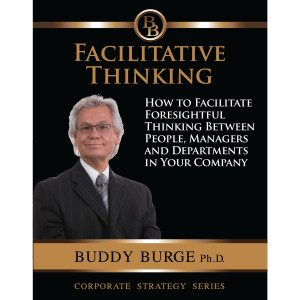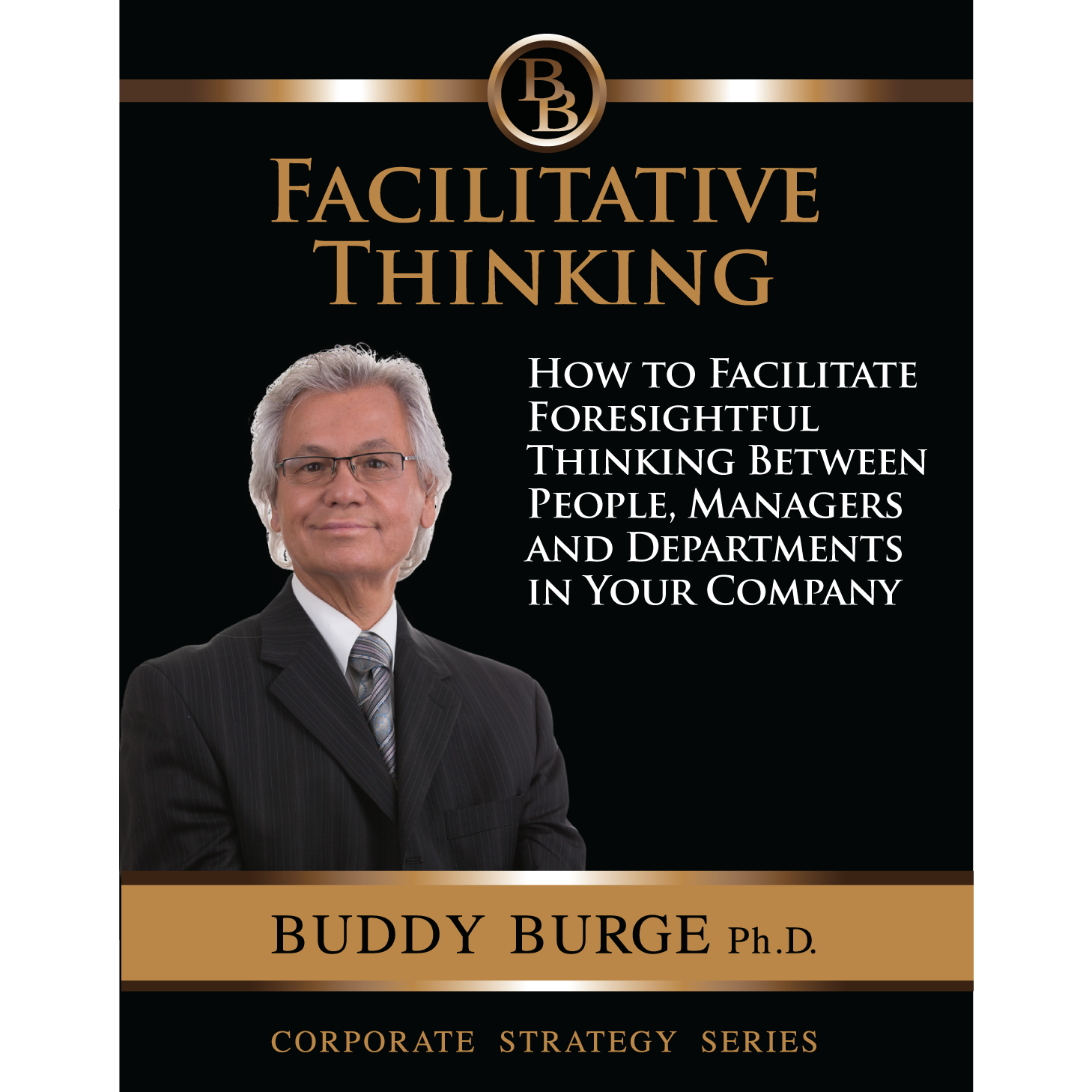This article is taken from Buddy’s book “Facilitative Thinking”
The Nature, Dimensions and Realities of Luck
In the next three articles, including this one, I will endeavor to provide you three ways to improve your luck.
The most extensive study ever on the notion of luck was conducted by Jim Collins and Horace Hansen.
They studied seven very successful companies (and their history, from 1970 to 2002), that had attained exceptional long term results in highly uncertain and chaotic industries and matched them against seven companies with only average performance.
By applying a consistent methodology, they and their research team were able to use an evidence-based analysis to attack the elusive topic of “luck”, focusing on the question:
“Do the successful people or companies get more good luck, or less bad luck, than the comparison companies?”
In the process, they discovered that there are nine ways to improve your luck.
Nine Ways to Improve your Luck
1. Fire Bullets, Then Fire Cannonballs
2. The Danger of Achieving Good Outcomes from Bad Process.
3. The “Who” is as Important as the “What”
4. Realize that Luck Happens, Good and Bad, to Everyone, Whether We Like It or Not
5. A Far Better Fit with the Data: A Synthesizing Concept, Return on Luck
6. Resilience, not Luck, is the Signature of Greatness
7. There’s Only One Truly Definitive Form of Luck
8. Luck is Not a Strategy
9. Luck Might Not be a Strategy, But Getting a Positive Return on Luck Is
Improve your Luck Strategy Number One:
Fire Bullets then Cannonballs
While successful peoples don’t “cause” their luck, they increase the chances of stumbling upon something that looks like luck.
Picture yourself at sea, a hostile ship bearing down on you.
You have a limited amount of gunpowder.
You take all your gunpowder and use it to fire a big cannonball.
The cannonball flies out over the ocean and misses the target, off by 40 degrees.
You turn to your stockpile and discover that you’re out of gunpowder. You die.
But suppose instead that when you see the ship bearing down, you take a little bit of gunpowder and fire a bullet. It misses by 40 degrees.
You make another bullet and fire. It misses by 30 degrees.
You make a third bullet and fire, missing by only 10 degrees.
The next bullet hits, ping, the hull of the oncoming ship.
Now, you take all the remaining gunpowder and fire a big cannonball along the same line of sight, which sinks the enemy ship.
You live.
The Three Principles to Adaption
The great Russian thinker Palchinsky said something like the “bullets, then cannonballs” theory a hundred years ago.
He articulated the three essential steps we need to use to effectively adapt to the vagaries that visit themselves upon us business and everyday life.
First, try new things, expecting that some will fail.
Second, make failure survivable (bullets not cannonballs): create safe spaces for failure or move forward in small steps. The trick here is finding the right scale in which to experiment: significant enough to make a difference, but not such a gamble that you’re ruined if it fails.
Thirdly, and most importantly for our purposes, make sure you know when you’ve failed, or you will never learn.
What Makes a Bullet?
A bullet is an empirical test aimed at learning what works and that meets three criteria:
1. A bullet is low cost.
Note: the size of a bullet grows as the enterprise grows; a cannonball for a $1 million enterprise might be a bullet for a $1 billion enterprise.
2. A bullet is low risk.
Note: low risk doesn’t mean high probability of success; low risk means that there are minimal consequences if the bullet goes awry or hits nothing.
3. A bullet is low distraction.
Note: this means low distraction for the overall enterprise; it might be very high distraction for one or a few individuals.
Successful People and Companies use a Combination of Creative Bullets Such as New
- Technologies
- Services
- Processes
- And acquisitions.
For any endeavor we undertake to qualify as a bullet, it needs to meet the three tests:
- Low cost
- Low risk
- Low distraction.
My rule of thumb is, once I am 80% sure, I go full bore or begin to fire my first cannonball.
The Dangerous Lure of Uncalibrated Cannonballs
Calibrate means to adjust or standardize something.
Do not fire a cannonball until it has been adjusted or calibrated to what is a realistic assessment of reasoned possibility of success.
How do we do that?
Embracing the “fire bullets, then cannonballs” principle requires a combination of activities:
- Fire bullets.
- Assess: Did your bullets hit anything?
- Consider: Do any of your successful bullets merit conversion to a big cannonball?
- Convert: Concentrate resources and fire a cannonball once calibrated.
- Don’t fire uncalibrated cannonballs.
- Terminate bullets that show no evidence of eventual success.
To Get Anywhere in Life, you will need to Fire the Odd Cannonball
The key is not to fire cannonballs before calibrating your situation that is getting empirical validation gained through actual experience, that the cannonball would likely reach its intended target.
A cannonball fired before you gain empirical validation is an uncalibrated cannonball.
The successful people are much more likely to fire calibrated cannonballs, while the rest tend to have uncalibrated cannonballs flying all over the place.
In his research on this issue, Collins found that successful people and companies had a 69 percent calibration rate on cannonballs as opposed to 22 percent for those who failed.
He found that people or companies who used or fired only calibrated cannonballs had a success rate nearly four times higher than uncalibrated cannonballs, 88 percent to 23 percent.
Everybody at some point has to fire cannonballs, marriage, purchase new car, start a new company and the like.
The rule is to not fire cannonballs before getting calibration, empirical validation gained through actual experience, that the cannonball will likely reach its intended target.
Improve your Luck Strategy Number Two:
The Danger of Achieving Good Outcomes from Bad Process
Good process doesn’t guarantee good outcomes, and bad process doesn’t guarantee bad, but good outcomes with bad process, firing uncalibrated cannonballs that just happen to succeed, reinforces bad process and can lead to firing more uncalibrated cannonballs.
Even a blind squirrel finds an acorn sometimes and a golfer with a bad swing makes the odd good shot.
Would you advise a friend or relative to go to Las Vegas and bet half of his entire net worth on a single spin of the roulette table?
Suppose your friend believes that people win big only if they make big risky bets on games like roulette, and he heads off to Vegas, places a huge roulette bet, and wins. He comes home and says, “See, it’s a good idea to bet on roulette, just look at my success. I’m going back next week to bet my entire net worth!”
Learn From Your Follies
Successful people (remember the object in life is not to be perfect but to be successful) don’t have perfect records in calibrating their cannonballs.
But when we do fire the odd uncalibrated cannonballs, as quickly as possible, learn from your mistakes and return to your bullets-then-cannonballs approach.
Improve your Luck Strategy Number Three:
The Who is as Important as the What
We tend to think of luck as a “what” variable, the plane flies by at the right moment, your IPO becomes much more successful than expected, etc.
But one of the most significant forms of luck comes not as “What” but in the form of “Who”.
In a family business, for example, there’s a significant amount of luck in whether a son or daughter has the right stuff to lead a company to greatness.
Progressive Insurance for example began as a small family business in Cleveland, Ohio, and the family owners got a remarkable successful son in Peter Lewis, who took over the company in 1965.
The environment can affect but doesn’t necessarily determine why some companies thrive in chaos and why others don’t
People Make the Difference
People lead. People build teams.
People build organizations.
People build cultures.
People exemplify values, pursue purpose, and achieve big hairy audacious goals.
Of all the luck we can get, people luck, the luck of finding the right mentor, partner, teammate, leader, friend, is one of the most important.
In the next article we will discuss three more ways, strategies four to six, to improve your luck.
Until then, good luck.
For more on this topic, we recommend the following | |
 | Facilitative ThinkingHow to Facilitate Foresightful Thinking Click Here For Video and Full Description If you found this article useful |


![CropperCapture[193]](http://buddyburge.com/wp-content/uploads/2014/02/CropperCapture1931-300x254.png)
![CropperCapture[194]](http://buddyburge.com/wp-content/uploads/2014/02/CropperCapture1941-300x187.png)
![CropperCapture[195]](http://buddyburge.com/wp-content/uploads/2014/02/CropperCapture1951-300x205.png)
![CropperCapture[196]](http://buddyburge.com/wp-content/uploads/2014/02/CropperCapture1961-300x277.png)
![CropperCapture[197]](http://buddyburge.com/wp-content/uploads/2014/02/CropperCapture1971-300x265.png)
![CropperCapture[198]](http://buddyburge.com/wp-content/uploads/2014/02/CropperCapture1981-300x284.png)
![CropperCapture[199]](http://buddyburge.com/wp-content/uploads/2014/02/CropperCapture1991-300x229.png)
![CropperCapture[200]](http://buddyburge.com/wp-content/uploads/2014/02/CropperCapture2001-300x266.png)
![CropperCapture[201]](http://buddyburge.com/wp-content/uploads/2014/02/CropperCapture2011-300x218.png)
